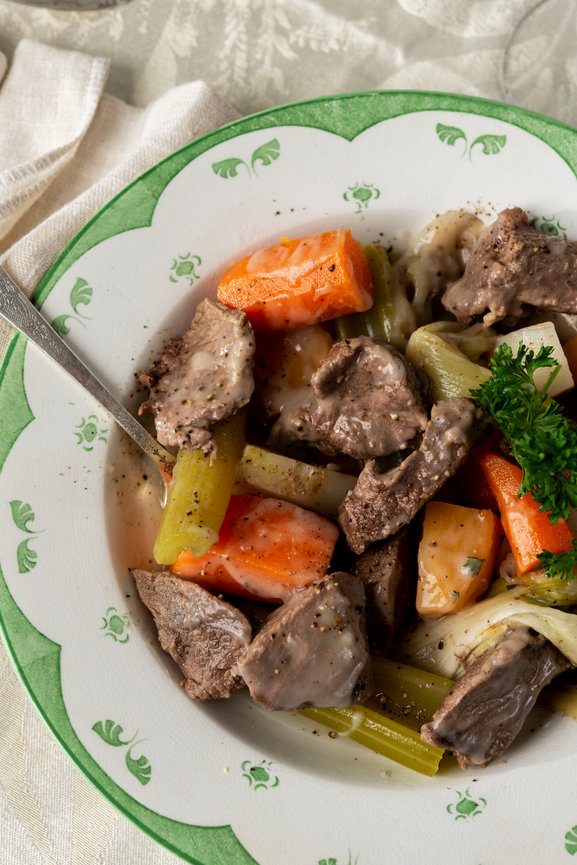Salmon en Papillote and Potato Croquettes
Wednesday, January 13, 2016 | By: Becky Diamond
In France, en papillote was one of the elegant cooking techniques that arose from the classic French haute cuisine of the eighteenth century. Like a special delivery package, these delightful parcels were served to French nobility in their grand chateaus and manors and with dramatic fanfare, cut open at the table to reveal their steaming, fragrant deliciousness.
Although 19th century French import Pierre Blot did not introduce the concept to America, this is exactly the type of dish he featured in his cooking school and demonstrations. Blot was a French chef who landed in New York City in 1855 and opened what many food experts consider the first school of French cookery in the U.S. Often described as America’s first celebrity chef, he was determined to raise American cookery to an art form, using the school (dubbed Blot’s Culinary Academy of Design in a New York Times article) as an opportunity to share his ideals. He became hugely popular, teaching and giving demonstrations throughout the Northeast as well as writing a number of cookbooks and articles on a variety of culinary topics. Unfortunately he fell out of favor with the American public by the early 1870s, although it is not clear exactly why.
He is a culinary figure whose life and teachings warrant more study and analysis, which I hope to uncover in my next book. As I delve into my research, I thought it would be prudent to try some of his seemingly complicated recipes, starting with Salmon en Papillotes from Blot’s 1868 cookbook, Handbook of Practical Cookery, for Ladies and Professional Cooks. I had cooked fish in foil packets before and know from experience that the steam inside cooks the fish to moist, juicy perfection. This time I decided to use parchment paper exactly as Blot would have done.
Here is his recipe:
Fry slices of salmon with a little butter, and until of a golden color; take them from the fire. While they are frying, mix well together parsley chopped fine, salt, pepper, melted butter, grated nutmeg, and a little lemon-juice; spread some of the mixture on both sides of the slices of fish, envelop them in buttered or oiled paper; broil, and serve them hot.
I followed these instructions fairly closely; the only thing I didn’t do was fry the fish first – salmon is already such a rich fish that I didn’t think it needed this step. I just rubbed the parsley-spice mixture on the fish and placed it on a piece of slightly oiled parchment, wrapped it up and then baked it at 400 for 10-15 min. It was delicious! I don’t think anything was lost by not frying ahead of time. Moist and flavorful – not dry at all which can sometimes happen with a thick cut of fish. A tasty dish that is easy to prepare and equally perfect for a weeknight or a fancy dinner party – and made with ingredients most folks probably have on hand.
Here’s Blot’s instructions:
Peel, quarter, and boil about a quart of potatoes as directed. Mash them in a saucepan and mix them with four yolks of eggs, two ounces of butter, salt, and about half a gill of milk; set on the fire, stir for about two minutes, take off, spread on a dish and leave thus for two or three hours, and even overnight when for breakfast. When left over night, they may be rather too dry to work them; then mix with a few drops of milk. No matter how long they have been left on the dish, it is necessary to mix them, that is, to mix the top, which is the driest part, with the rest. Dust the paste-board slightly with bread crumbs, put the potatoes on it, in parts of about a tablespoon each; then with the hands and a knife, shape them according to fancy, either round, flat or oval, etc. When shaped round they look like a piece of sausage about two inches and a half long. If wished flat, when shaped round, juts flatten them a little with the blade of a knife. Then dip each part in beaten egg, roll in bread-crumbs, and fry in hot fat. Take them off the fat when done, turn them into a colander, and immediately dish, and serve them as warm as possible. Potato croquettes are sometimes called potato balls. When the croquettes are shaped flat, they are also called “a la duchesse.”
Once again I followed the recipe pretty much verbatim, except I didn’t leave the potatoes to sit for that long – just about 15 min or so, which I think was fine. Also, a gill of milk is about a ½ cup. And instead of frying them in fat, I used canola oil. They are basically fried mashed potato balls. My family LOVED them! I will definitely make both dishes again. Stay tuned for more on Pierre Blot and his recipes!






Leave a comment
0 Comments